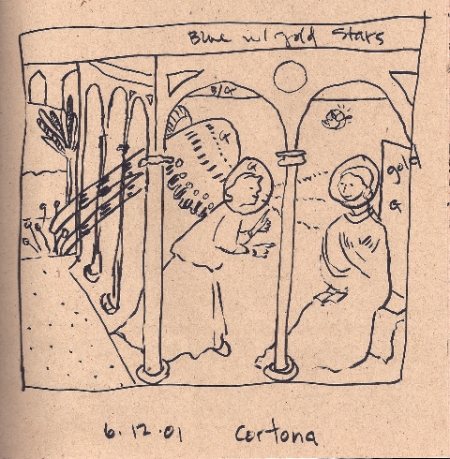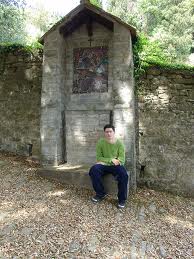Inside Cortona
The Futurist painter Gino Severini (1883-1966), who hailed from Cortona, had this to say about the place: “Cortona is a small Tuscan town of Etruscan origin built on a hillside near the Umbrian border. It is characterized by steep, narrow, roughly paved lanes. There are two beautiful, spacious town squares and a single wide and level main street that, in my day, was called the ‘Rugapiana’ or ‘flat wrinkle.’ There are also a number of convents. The inhabitants are notoriously rugged, fiercely proud, and independent. Among Cortona’s most illustrious natives are Luca Signorelli [the painter], Pietro da Cortona [the architect], and Saint Margaret [the patron saint of childbirth, among other things].” Source: Gino Severini, The Life of a Painter.
Here’s that aerial view from last time, demonstrating beyond doubt that Cortona is a hill town:
And here again is the entry into town–quite a narrow street (the wide “flat wrinkle” that Severini mentions must be somewhere else; we’ll inquire). Having left our hotel a few yards to the left, let’s head into town . . .
. . . in whatever manner you prefer:
These members of our tour in 2008 were in search of cappucino, and they found some not far away. Here’s the one that Bonnie documented before sipping:

The narrow entry street opens into one of the spacious plazas that Severini mentions, and a major building there is the beautiful arched Teatro:
A little further on is the Diocesan Museum, which contains a variety of treasures, including the famous Cortona Annunciation (1430s), painted by Fra Angelico:
Fra Angelico, a Dominican monk as well as a famous painter, was from Florence but spent several years in Cortona. His most famous work done there is this lovely altarpiece depicting the angel Gabriel interrupting Mary’s reading to tell her that she will be the mother of Jesus. Her book nearly slips from her lap. When we visit the Diocesan Museum, we’ll pause to remark on this painting. It demonstrates a quality for which Fra Angelico’s works are known: the quality of “devoto”–a word originally used to describe a type of rhetoric that is calm, meditative, simple, avoiding excessive ornament, plain-spoken, the rhetoric of a persuasive preacher delivering a heartfelt sermon. Fra Angelico adapts this mode of rhetoric to painting. His visual “sermon” concerns the purity of Mary and her humble yet joyful response to the angel Gabriel’s message from God.
When Bonnie first saw this painting in 2001, she made this study sketch to help her remember it:

Above the drawing, she wrote: “clear and stunning–much gold–intricate beautiful faces–garden exquisite–predella to die for.” Predella? That’s the row of little paintings across the bottom, depicting in this case the life of Mary before and after the big event in the main scene.
Most of the art we will see in Cortona is Renaissance Christian painting or ancient Etruscan bronzes, such as these cheerful little personages, as sketched by Bonnie:
But twentieth-century art by Gino Severini, Cortona’s native son, is there as well. On a wall not far from out hotel, in fact, is Severini’s big mosaic of Saint Mark:
Cortona buildings are depicted in the background, as the evangelist Mark gives us an eye message, as does his mascot the lion. I love the way the Biblical subject is given 1950s modern art treatment in the form of abstract patterns and streamlined effects of the sort, as a Futurist, Severini introduced into European art in the early years of the century.
The Saint Mark mosaic is located near the foot of a long, steep walkway lined with smaller mosaics by Severini depicting the Stations of the Cross. When Bonnie and I visited Cortona in 2005, we heard about these, searched them out, and took a look at every one of them, making our way up an extremely steep street leading to a hilltop church. We were mighty breathless when we reached the summit, where, thankfully, there is not only the church but also a snack bar.
Here’s a guy I got off Google who is pausing in front of one of the mosaics, which are set into shrines:
This trek is a free-time option for the sturdy among us. The mosaics are lovely though sometimes hard to see because of the protective sheets of plexiglass that cover them. Taking this walk is a good way to remind yourself that Cortona is indeed “characterized by steep, narrow, roughly paved lanes,” as Severini warned.
So–a taste of Cortona, a lovely place to have at the center of our touring.
In the next post, we will head into Umbria to see about Assisi, hometown to Saint Francis.
RH








Leave a comment